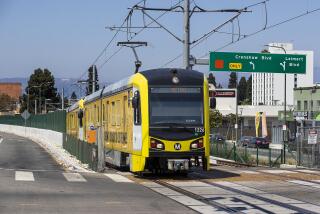MTA Increases Estimates of Valley Busway Commute Time
A proposed busway across the San Fernando Valley will probably not reduce commute times as much as had been anticipated, according to the Metropolitan Transportation Authority’s latest estimates.
And the east-west busway’s final environmental impact report makes some concessions to vociferous opponents by proposing added pedestrian paths and more sound walls along the 14-mile route.
For the record:
12:00 a.m. Feb. 15, 2002 FOR THE RECORD
Los Angeles Times Friday February 15, 2002 Valley Edition Main News Part A Page 2 Zones Desk 1 inches; 32 words Type of Material: Correction
MTA chairman--A story Wednesday in the California section incorrectly identified Los Angeles County Supervisor Zev Yaroslavsky as chairman of the Metropolitan Transportation Authority board. Yaroslavsky is a board member.
The report is “responsive to the public comments we received,” said Los Angeles County Supervisor Zev Yaroslavsky, who chairs the MTA board.
Yaroslavsky shrugged off the report’s estimate that a ride between its end points at Warner Center in Woodland Hills and North Hollywood’s Metro Red Line subway station could take 35 to 40 minutes. Last year, the MTA said such a ride would take as little as 28.8 minutes.
“It’s still better than an hour and 15 minutes on the 101 [Freeway],” Yaroslavsky said. “It’s an alternative to sitting in traffic.”
The report, an update of a draft prepared last summer, is expected to be approved by the MTA board at its Feb. 28 meeting. Then, officials plan to choose a contractor, begin construction in spring 2003 and open the busway in spring 2005.
Some community members are shuddering at the thought.
“It will destroy our neighborhood ... our whole area,” said Jill Haber, chairwoman of West Valley Concerned Citizens, one of many community groups opposing the project.
Critics say the corridor, which could have hundreds of buses running every day, would harm their communities with congestion and noise. Concerns about air pollution were assuaged by MTA officials’ promise to use “clean fuel” buses.
Orthodox Jews who live and walk to their synagogue in the East Valley area fear the frequent buses would inconvenience or endanger pedestrians.
Reversing itself since the draft study, the MTA now proposes to build several pedestrian paths along the corridor. And to accommodate Orthodox Jews who cannot do any work--including pushing buttons on mechanical devices--on their Sabbath and holidays, crosswalk signals would be operated by a timer on those days.
More “traffic calming measures” will be implemented, such as adding left and right turn pockets and diverting cars away from residential neighborhoods, said project manager Kathleen Sanchez. The MTA plans to build 6,100 additional feet of sound walls, bringing the total to 29,500 feet.
But bus rides will take longer than previously anticipated, Sanchez said, because the city of Los Angeles Department of Transportation told the MTA it will not synchronize traffic signals to the degree the agency had expected.
Transportation officials denied that assertion. The agency has long planned to synchronize traffic signals along the corridor, said James Okazaki, assistant general manager. He criticized the MTA’s earlier analysis of travel time as “unreasonable” and said it would be possible only if there were no cars trying to cross the corridor and the buses made no stops.
Some of the corridor’s opponents said they feel defeated despite the MTA’s concessions.
Rabbi Marvin Sugarman said he still opposes the transit corridor despite improvements for pedestrians, because it would still directly face his Shaarey Zedek Temple in Valley Village on Chandler Boulevard and disrupt his congregation’s tranquillity.
“We have been vehemently opposed to this from the very beginning,” Sugarman said. “We haven’t had the power to overcome this stupidity.”
Others say the project, which began years ago as a subway proposal, is long overdue.
Mel Wilson, co-chairman of the Valley Industry and Commerce Assn.’s ground transportation committee, called busway opponents “a very boisterous minority.”
A busway will “do a lot of good for a majority of folks,” Wilson said. “Now it’s time to build.”
More to Read
Sign up for Essential California
The most important California stories and recommendations in your inbox every morning.
You may occasionally receive promotional content from the Los Angeles Times.










